Boston
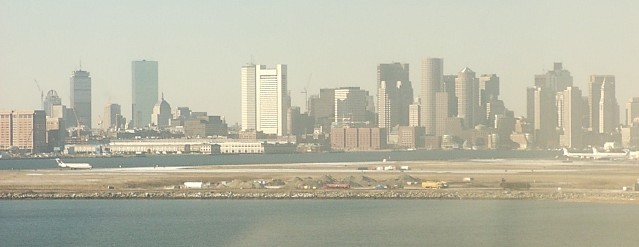
This is the city of Boston as seen from a plane landing at Logan Airport. There's a little bit of glare off the plane
window but they don't seem to really be designed for optimal photography. The background is another view of
the skyline from the north.

After meeting David's mom at the airport (which was impressive because she had negative 7 minutes to change planes
in New York and still made it), and dropping the luggage off at the airport, we chose the Quincy Market area of
downtown as the first place to freeze to death. Quincy Market is a historic marketplace in Boston which has been
joined by the parallel north and south markets. They don't appear particularly historic these days. That's the north
market in the foreground of this picture.
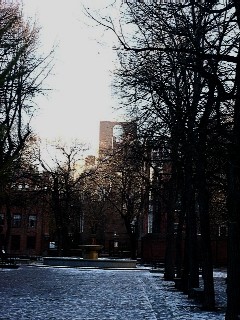
After some time at the marketplace, we followed the Freedom Trail (a red brick line directing tourists to all the official
historic sites in the city) into the north end which is now primarily an Italian neighborhood. Paul Revere is one of the
north end's more famous residents. His house is still standing amidst a sea of taller brick apartment buildings. This
is the Paul Revere plaza located appropriately just behind the Old North Church from whence he began his famous
ride.

And this is the Old North Church from the front - or as close to the front as one can really get. Photography is not
allowed inside the church. Along with a vast number of historical markers and plaques, the box pews are labelled as
to who they originally belonged to.
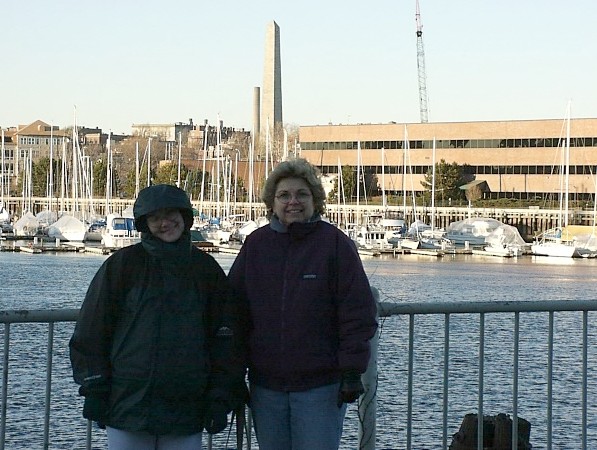
Here are David's mom and Melanie freezing alongside the Charles River. This is as far as we followed the Freedom
Trail on the first day because the next step was a long bridge exposed to the wind. The obelisk in the background is
the Bunker Hill Monument. We visited the New England Aquarium after this and we do not have a single solitary
picture of an otter to show for it. Regular readers may find this shocking, but the aquarium has no river otters, and the
sea otters were kept outside and were not lit particularly well so we were unable to get a decent picture.
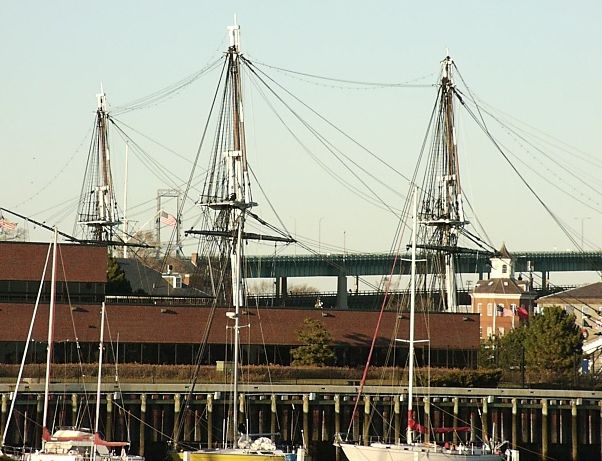
The taller masts in the background of this picture belong to Old Ironsides, A.K.A. the Constitution. We never visited
the Constitution but we have several pictures of it anyways. This is from across the Charles River. After the aquarium
we dodged a horde of half-drunk Santa Clauses (no, seriously) and claimed a table at an Irish Pub downtown. It was here
that mom had her first 'nutty Irishman'. (She had 5 total for the trip.) This happens to be a coffee drink with one or more
liquours in it that probably include Irish Cream, Kahlua and Frangelico, though it seems to vary a bit. We returned to the
hotel for another round of these later.
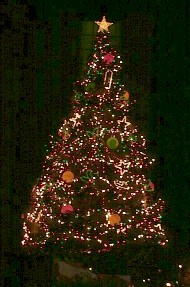
Our second day in Boston suffers from a dearth of pictures. We visited the Museum of Fine Arts which is enormous,
and not only has a big sculpture out front.. but a little version of the big one inside too. (This is the type of phrasing
that can come from viewing too many DeKoonig sculptures - or in this case, one.) Anyway, we saw most of the Broadway
production of 'Death of a Salesman' that afternoon and then spent the evening shopping in Back Bay. This is the
Christmas Tree at Prudential Plaza, there isn't much scale I'm afraid but the first row of lights is about 10 feet off the ground.

On our third and final day in Boston, we took the 'T' to Charlestown and continued our Freedom Trail exploration.
This of course is the Bunker Hill monument again. As is so often pointed out in U.S. History, this is not really
Bunker Hill, it is Breeds Hill. Bunker Hill is just to the south and slightly higher, but the colonial general order to
fortify Bunker Hill apparently decided that this hill was a better place to defend.

Bunker Hill, or its monument at least, is located in Charlestown, which isn't really a separate city but a part
of Boston. It has its own identity though and is filled with colorful, contiguous, New England style homes like
these.
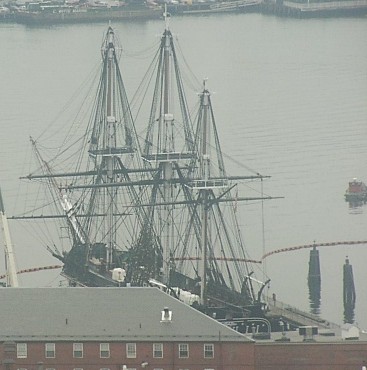
One can climb to the top of the Bunker Hill Monument, which was built in the first half of the 19th century. There are 294
steps and 0 elevators. It is a spiralling staircase as well so by the time you get to the top, one leg is shorter than the other
one. Don't let this deter you though, they'll even out on the way down. Here is the Constitution again as seen from atop
the monument.

Here is Melanie about to base jump from the Bunker Hill Monument. No, not really, there's glass there.
The battle of Bunker Hill was important because even though the revolutionaries lost (yes, we lost the battle
of Bunker Hill, pay attention), the British suffered a ridiculous number of casualties to gain the relatively meaningless
hill. General Nathaniel Greene was later quoted as saying, "I wish we could sell them another hill at the same price".
Of course, this might have something to do with marching in straight lines and wearing bright red jackets versus hiding
behind logs and wearing earth tones but we aren't really here to comment on military history.
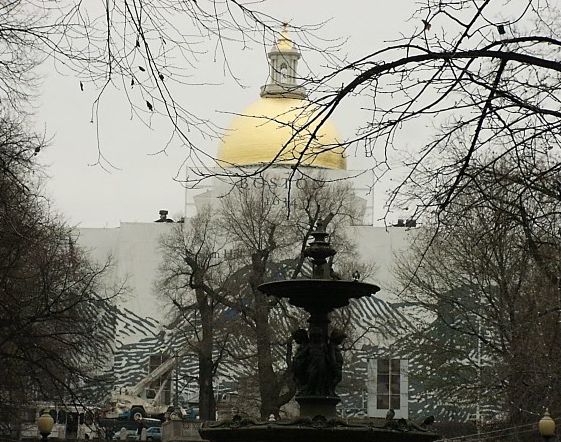
We are often here to comment on the architecture of US capitol buildings though. Unfortunately, Boston's was
largely under reconstructive efforts at the time so you can't see much other than the dome.
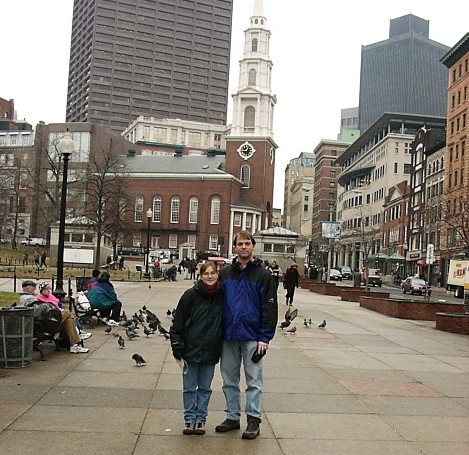
Here are Melanie and I at one corner of the Boston Commons - a large city park in the middle of the downtown area.
It was much warmer on this day than the first day as you might be able to tell by the fact that Melanie is exposing her
hair to the world in this picture.

We also returned to Faneuil Hall, which we had visited the first day. Faneuil Hall is given a variety of monikers, most
of which have also been given to Independence Hall in Philadelphia. For instance, 'the cradle of liberty'. Faneuil Hall
has been an important meeting place as long as Boston has been an important city. Paul Revere, John Hancock, and
Sam and John Adams acted out many of their most famous scenes here. Nowadays, the first floor is a marketplace but
the meeting hall remains upstairs.
 This is the city of Boston as seen from a plane landing at Logan Airport. There's a little bit of glare off the plane
window but they don't seem to really be designed for optimal photography. The background is another view of
the skyline from the north.
This is the city of Boston as seen from a plane landing at Logan Airport. There's a little bit of glare off the plane
window but they don't seem to really be designed for optimal photography. The background is another view of
the skyline from the north.
 This is the city of Boston as seen from a plane landing at Logan Airport. There's a little bit of glare off the plane
window but they don't seem to really be designed for optimal photography. The background is another view of
the skyline from the north.
This is the city of Boston as seen from a plane landing at Logan Airport. There's a little bit of glare off the plane
window but they don't seem to really be designed for optimal photography. The background is another view of
the skyline from the north.
 After meeting David's mom at the airport (which was impressive because she had negative 7 minutes to change planes
in New York and still made it), and dropping the luggage off at the airport, we chose the Quincy Market area of
downtown as the first place to freeze to death. Quincy Market is a historic marketplace in Boston which has been
joined by the parallel north and south markets. They don't appear particularly historic these days. That's the north
market in the foreground of this picture.
After meeting David's mom at the airport (which was impressive because she had negative 7 minutes to change planes
in New York and still made it), and dropping the luggage off at the airport, we chose the Quincy Market area of
downtown as the first place to freeze to death. Quincy Market is a historic marketplace in Boston which has been
joined by the parallel north and south markets. They don't appear particularly historic these days. That's the north
market in the foreground of this picture.  After some time at the marketplace, we followed the Freedom Trail (a red brick line directing tourists to all the official
historic sites in the city) into the north end which is now primarily an Italian neighborhood. Paul Revere is one of the
north end's more famous residents. His house is still standing amidst a sea of taller brick apartment buildings. This
is the Paul Revere plaza located appropriately just behind the Old North Church from whence he began his famous
ride.
After some time at the marketplace, we followed the Freedom Trail (a red brick line directing tourists to all the official
historic sites in the city) into the north end which is now primarily an Italian neighborhood. Paul Revere is one of the
north end's more famous residents. His house is still standing amidst a sea of taller brick apartment buildings. This
is the Paul Revere plaza located appropriately just behind the Old North Church from whence he began his famous
ride.  And this is the Old North Church from the front - or as close to the front as one can really get. Photography is not
allowed inside the church. Along with a vast number of historical markers and plaques, the box pews are labelled as
to who they originally belonged to.
And this is the Old North Church from the front - or as close to the front as one can really get. Photography is not
allowed inside the church. Along with a vast number of historical markers and plaques, the box pews are labelled as
to who they originally belonged to.
 Here are David's mom and Melanie freezing alongside the Charles River. This is as far as we followed the Freedom
Trail on the first day because the next step was a long bridge exposed to the wind. The obelisk in the background is
the Bunker Hill Monument. We visited the New England Aquarium after this and we do not have a single solitary
picture of an otter to show for it. Regular readers may find this shocking, but the aquarium has no river otters, and the
sea otters were kept outside and were not lit particularly well so we were unable to get a decent picture.
Here are David's mom and Melanie freezing alongside the Charles River. This is as far as we followed the Freedom
Trail on the first day because the next step was a long bridge exposed to the wind. The obelisk in the background is
the Bunker Hill Monument. We visited the New England Aquarium after this and we do not have a single solitary
picture of an otter to show for it. Regular readers may find this shocking, but the aquarium has no river otters, and the
sea otters were kept outside and were not lit particularly well so we were unable to get a decent picture.  The taller masts in the background of this picture belong to Old Ironsides, A.K.A. the Constitution. We never visited
the Constitution but we have several pictures of it anyways. This is from across the Charles River. After the aquarium
we dodged a horde of half-drunk Santa Clauses (no, seriously) and claimed a table at an Irish Pub downtown. It was here
that mom had her first 'nutty Irishman'. (She had 5 total for the trip.) This happens to be a coffee drink with one or more
liquours in it that probably include Irish Cream, Kahlua and Frangelico, though it seems to vary a bit. We returned to the
hotel for another round of these later.
The taller masts in the background of this picture belong to Old Ironsides, A.K.A. the Constitution. We never visited
the Constitution but we have several pictures of it anyways. This is from across the Charles River. After the aquarium
we dodged a horde of half-drunk Santa Clauses (no, seriously) and claimed a table at an Irish Pub downtown. It was here
that mom had her first 'nutty Irishman'. (She had 5 total for the trip.) This happens to be a coffee drink with one or more
liquours in it that probably include Irish Cream, Kahlua and Frangelico, though it seems to vary a bit. We returned to the
hotel for another round of these later.
 Our second day in Boston suffers from a dearth of pictures. We visited the Museum of Fine Arts which is enormous,
and not only has a big sculpture out front.. but a little version of the big one inside too. (This is the type of phrasing
that can come from viewing too many DeKoonig sculptures - or in this case, one.) Anyway, we saw most of the Broadway
production of 'Death of a Salesman' that afternoon and then spent the evening shopping in Back Bay. This is the
Christmas Tree at Prudential Plaza, there isn't much scale I'm afraid but the first row of lights is about 10 feet off the ground.
Our second day in Boston suffers from a dearth of pictures. We visited the Museum of Fine Arts which is enormous,
and not only has a big sculpture out front.. but a little version of the big one inside too. (This is the type of phrasing
that can come from viewing too many DeKoonig sculptures - or in this case, one.) Anyway, we saw most of the Broadway
production of 'Death of a Salesman' that afternoon and then spent the evening shopping in Back Bay. This is the
Christmas Tree at Prudential Plaza, there isn't much scale I'm afraid but the first row of lights is about 10 feet off the ground.
 On our third and final day in Boston, we took the 'T' to Charlestown and continued our Freedom Trail exploration.
This of course is the Bunker Hill monument again. As is so often pointed out in U.S. History, this is not really
Bunker Hill, it is Breeds Hill. Bunker Hill is just to the south and slightly higher, but the colonial general order to
fortify Bunker Hill apparently decided that this hill was a better place to defend.
On our third and final day in Boston, we took the 'T' to Charlestown and continued our Freedom Trail exploration.
This of course is the Bunker Hill monument again. As is so often pointed out in U.S. History, this is not really
Bunker Hill, it is Breeds Hill. Bunker Hill is just to the south and slightly higher, but the colonial general order to
fortify Bunker Hill apparently decided that this hill was a better place to defend.  Bunker Hill, or its monument at least, is located in Charlestown, which isn't really a separate city but a part
of Boston. It has its own identity though and is filled with colorful, contiguous, New England style homes like
these.
Bunker Hill, or its monument at least, is located in Charlestown, which isn't really a separate city but a part
of Boston. It has its own identity though and is filled with colorful, contiguous, New England style homes like
these.  One can climb to the top of the Bunker Hill Monument, which was built in the first half of the 19th century. There are 294
steps and 0 elevators. It is a spiralling staircase as well so by the time you get to the top, one leg is shorter than the other
one. Don't let this deter you though, they'll even out on the way down. Here is the Constitution again as seen from atop
the monument.
One can climb to the top of the Bunker Hill Monument, which was built in the first half of the 19th century. There are 294
steps and 0 elevators. It is a spiralling staircase as well so by the time you get to the top, one leg is shorter than the other
one. Don't let this deter you though, they'll even out on the way down. Here is the Constitution again as seen from atop
the monument.  Here is Melanie about to base jump from the Bunker Hill Monument. No, not really, there's glass there.
The battle of Bunker Hill was important because even though the revolutionaries lost (yes, we lost the battle
of Bunker Hill, pay attention), the British suffered a ridiculous number of casualties to gain the relatively meaningless
hill. General Nathaniel Greene was later quoted as saying, "I wish we could sell them another hill at the same price".
Of course, this might have something to do with marching in straight lines and wearing bright red jackets versus hiding
behind logs and wearing earth tones but we aren't really here to comment on military history.
Here is Melanie about to base jump from the Bunker Hill Monument. No, not really, there's glass there.
The battle of Bunker Hill was important because even though the revolutionaries lost (yes, we lost the battle
of Bunker Hill, pay attention), the British suffered a ridiculous number of casualties to gain the relatively meaningless
hill. General Nathaniel Greene was later quoted as saying, "I wish we could sell them another hill at the same price".
Of course, this might have something to do with marching in straight lines and wearing bright red jackets versus hiding
behind logs and wearing earth tones but we aren't really here to comment on military history.  We are often here to comment on the architecture of US capitol buildings though. Unfortunately, Boston's was
largely under reconstructive efforts at the time so you can't see much other than the dome.
We are often here to comment on the architecture of US capitol buildings though. Unfortunately, Boston's was
largely under reconstructive efforts at the time so you can't see much other than the dome.
 Here are Melanie and I at one corner of the Boston Commons - a large city park in the middle of the downtown area.
It was much warmer on this day than the first day as you might be able to tell by the fact that Melanie is exposing her
hair to the world in this picture.
Here are Melanie and I at one corner of the Boston Commons - a large city park in the middle of the downtown area.
It was much warmer on this day than the first day as you might be able to tell by the fact that Melanie is exposing her
hair to the world in this picture.  We also returned to Faneuil Hall, which we had visited the first day. Faneuil Hall is given a variety of monikers, most
of which have also been given to Independence Hall in Philadelphia. For instance, 'the cradle of liberty'. Faneuil Hall
has been an important meeting place as long as Boston has been an important city. Paul Revere, John Hancock, and
Sam and John Adams acted out many of their most famous scenes here. Nowadays, the first floor is a marketplace but
the meeting hall remains upstairs.
We also returned to Faneuil Hall, which we had visited the first day. Faneuil Hall is given a variety of monikers, most
of which have also been given to Independence Hall in Philadelphia. For instance, 'the cradle of liberty'. Faneuil Hall
has been an important meeting place as long as Boston has been an important city. Paul Revere, John Hancock, and
Sam and John Adams acted out many of their most famous scenes here. Nowadays, the first floor is a marketplace but
the meeting hall remains upstairs.